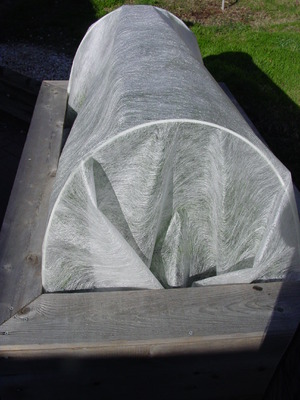Growing with a Cold Frame
 Wednesday, December 28, 2011 at 6:54PM
Wednesday, December 28, 2011 at 6:54PM The basic concept of a cold frame structure has been used in agriculture for centuries. Whatever the design and specific application, the function is the same : to allow the grower to create a microclimate around plants, and control the temperature, amount of sunlight, moisture, and wind exposure.
Here in Charlotte, which falls in the USDA’s Cold Hardiness Zone 7b, our winters are often extensions of Autumn, punctuated with a week or two of bitter cold. Cool season plants, like Cabbage and Broccoli for example, need no protection during a typical Charlotte winter, but will grow stronger and yield more with the help of a cold frame. When spring comes, a cold frame can also warm the soil in preparation for warm season plants, and protect them from a potential late frost.
Because frost protection is really only necessary for a few months out of the year here, the basic low tunnel style cold frame is a popular choice. It’s simple, sturdy and effective.
The design consists of a protective material stretched over a frame and secured to the ground much like a tent. Some growers use plastic sheeting, but I prefer and recommend a good quality row cover fabric Instead. Unlike plastic sheeting, high performance agricultural fabrics, like DuPont’s Pointbond series for example, allow air, water and light in, while protecting plants from frost, birds and insects.
To cover a typical row of about 3 to 4 feet in width, hoops can be made of 9 gauge galvanized wire cut to lengths of about seven feet, and spaced along the row about every four feet. Simply push each end of a section of wire into the ground on each side of the row until it is secure, then fit the fabric over the hoops, and secure it to the ground with landscape anchor pins. These pins can be purchased from landscape supply companies (sometimes called sod stakes) in 6” lengths for about 10 cents each ,or in 4” lengths from Lowe’s.
¼” Resin Coated, UV protected fiberglass rods are a step up from 9 gauge wire. They are strong, easy to install and easy to store away.
To cover a larger area with a cold frame, hoops can be fashioned by sliding sections of electrical conduit (unlike regular PVC, conduit is resistant to UV light) onto 2’ pieces of reinforcing bar staked into the ground about every four feet on both sides of the row. Stretch the fabric over the frame, and secure it to the ground with anchor pins.
Here, I’ve cut my conduit to 7’6” lengths so that my fabric, which is 8’ wide, can be staked down securely on each side. Remember to consider the total width of your fabric, and your anchor pins before cutting the material for your hoops. Note the use of 9 gauge galvanized wire for the cold frame in the adjacent, smaller row.
When using cold frames, remember that it’s more common for plants to die of heat and drought than from exposure to cold. Always use a fabric weight suited to your purpose, and remove the cold frame when danger of frost has passed.









Reader Comments